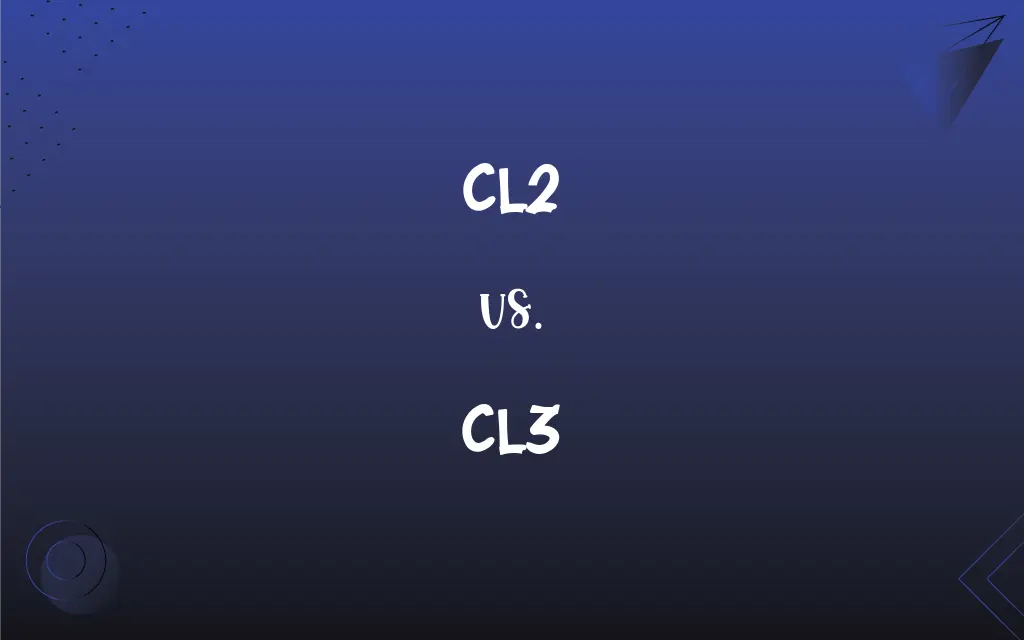CL2 vs. CL3: What's the Difference?
Edited by Janet White || By Harlon Moss || Published on February 24, 2024
CL2 and CL3 are classifications for electrical cable safety, with CL2 being for low voltage circuits and CL3 for higher voltage.

Key Differences
CL2 cables are designed for lower voltage applications, making them suitable for most consumer electronics and smaller devices. CL3 cables, on the other hand, are intended for higher voltage applications, offering a higher level of insulation and protection.
In terms of safety standards, CL2 cables are built to handle up to 150 volts, focusing on reducing the risks of electrical fires in low voltage systems. CL3 cables are rated for voltages up to 300 volts, providing an extra layer of safety for more powerful electrical systems.
Installation guidelines for CL2 and CL3 cables also differ. CL2 cables can be used in walls and ceilings without conduit, making them ideal for home audio systems. CL3 cables, given their higher voltage rating, are often required to be enclosed in conduit for added safety in commercial or industrial environments.
When it comes to interference, CL2 cables may be more susceptible to electronic noise and interference due to their lower insulation levels. CL3 cables, with their higher insulation, are better suited for environments where electromagnetic interference is a concern.
Cost and flexibility are other differentiating factors. CL2 cables are generally more affordable and flexible, suitable for a variety of common uses. CL3 cables, being more robust, are typically more expensive and less flexible but essential for specific high voltage applications.
ADVERTISEMENT
Comparison Chart
Voltage Rating
Rated for up to 150 volts
Rated for up to 300 volts
Safety Standards
Lower electrical fire risk
Higher insulation for extra safety
Installation Requirements
Can be used without conduit
Often requires conduit
Susceptibility to Interference
More susceptible to noise
Better protected against interference
Cost and Flexibility
More affordable and flexible
More expensive and less flexible
ADVERTISEMENT
CL2 and CL3 Definitions
CL2
CL2 cables are used primarily in residential and consumer electronics.
For our home theater, we need CL2 rated wires.
CL3
CL3 denotes a higher standard of cable used for higher voltage needs.
The projector requires CL3 rated cables due to its power requirements.
CL2
CL2 refers to cables designed for low voltage applications.
The audio system was safely wired using CL2 cables.
CL3
CL3 cables offer better insulation and protection against electrical hazards.
For our office's AV setup, we'll need the safety of CL3 cables.
CL2
CL2 is a standard set by the National Electrical Code (NEC) for certain types of cables.
Our installation must comply with NEC's CL2 standards.
CL3
CL3 cables are governed by stricter installation guidelines according to NEC.
The electrician ensured all CL3 cables were enclosed in a conduit.
CL2
CL2 ensures basic protection against fire hazards in low voltage systems.
CL2 wiring is essential for safety in our low voltage lighting.
CL3
CL3 cables are less flexible and more expensive than CL2 cables.
While CL3 cables are costlier, their safety benefits are worth it.
CL2
CL2 cables are not suitable for high voltage applications.
Avoid using CL2 cables for the high voltage equipment.
CL3
CL3 is commonly used in commercial and industrial applications.
The factory's sound system is wired with CL3 cables for added safety.
FAQs
Are CL3 cables safe for in-wall installation?
Yes, CL3 cables are safe for in-wall installation, often within conduit.
What are CL3 cables used for?
CL3 cables are used for higher voltage applications requiring more insulation.
Can CL2 cables be used in commercial buildings?
Yes, CL2 cables can be used in commercial buildings for low voltage needs.
Do CL2 cables require a conduit?
CL2 cables typically do not require a conduit for in-wall use.
Do CL3 cables offer better fire protection?
Yes, CL3 cables have better insulation, offering enhanced fire protection.
Is CL2 sufficient for computer networking cables?
Yes, for most home and office networks, CL2 is sufficient.
Do both CL2 and CL3 comply with NEC standards?
Yes, both are recognized under National Electrical Code standards.
What does CL2 stand for?
CL2 stands for Class 2, a cable rating for low voltage applications.
Can CL2 cables handle 300 volts?
No, CL2 cables are rated for up to 150 volts only.
Is it okay to use CL2 instead of CL3?
Only if the application meets the lower voltage and safety requirements of CL2.
Are CL2 cables suitable for high-end audio systems?
Yes, as long as the voltage requirements are within CL2 limits.
Can I use CL2 cables for outdoor lighting?
It's not recommended unless the lighting is low voltage and protected.
Are CL3 cables thicker than CL2?
Generally, yes, due to additional insulation and safety features.
What happens if I use CL2 in a CL3 required setup?
It may pose a safety risk due to inadequate voltage handling and insulation.
Is CL3 more expensive than CL2?
Yes, CL3 cables are generally more expensive due to higher safety standards.
What's the main difference in use between CL2 and CL3?
The main difference is the voltage rating and safety insulation.
Is it necessary to use CL3 in residential settings?
It depends on the specific electrical requirements and safety considerations.
Can CL3 be used for home theater systems?
Yes, CL3 can be used, especially for high-powered systems.
Are both CL2 and CL3 available in different lengths and thicknesses?
Yes, they are available in various lengths and gauges to suit different needs.
Can CL3 cables reduce electrical interference?
Yes, their better insulation can help reduce interference.
About Author
Written by
Harlon MossHarlon is a seasoned quality moderator and accomplished content writer for Difference Wiki. An alumnus of the prestigious University of California, he earned his degree in Computer Science. Leveraging his academic background, Harlon brings a meticulous and informed perspective to his work, ensuring content accuracy and excellence.
Edited by
Janet WhiteJanet White has been an esteemed writer and blogger for Difference Wiki. Holding a Master's degree in Science and Medical Journalism from the prestigious Boston University, she has consistently demonstrated her expertise and passion for her field. When she's not immersed in her work, Janet relishes her time exercising, delving into a good book, and cherishing moments with friends and family.































































